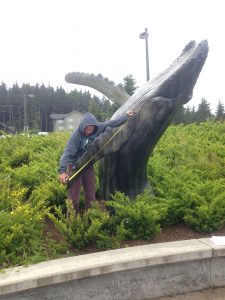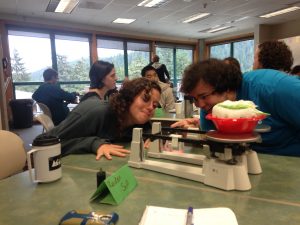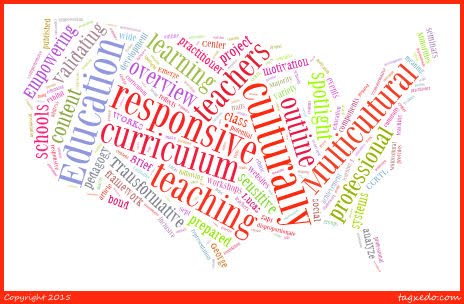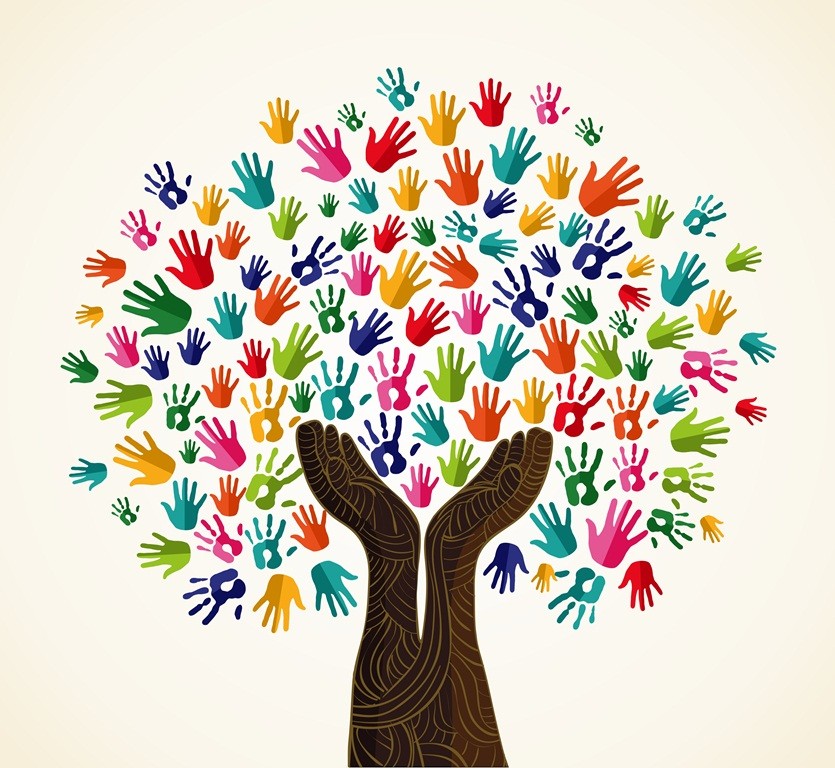I thoroughly enjoyed each of the master teachers that provided us with lessons on Friday. Tina Pasteris did a brilliant job in the creation of her ‘math trails’ activity that we participated in. The activity was more fun than I remember ever having in any of my math classes growing up, and it was fun for the students around me who said that math “isn’t their thing.” There were many layers to this activity, but as a whole, it required small groups of students to work together, have choices as to who performed what role in the group, play a game of sorts, get to know their surroundings, be introduced to different culturally relevant items and figure out some math skills all the while. We looked at art pieces, we went outside, we went into the library, we visited the coffee shop. By having many different types of math problems and exploring them through a moving trail, Tina allowed each of us to learn math and some important local cultural knowledge through our own cultural references. I was drawn to the art pieces- and learning math through the symmetry of one piece, the height of the totem pole and the hidden images in another piece. Other students commented on how lovely it was to find salmonberries while outside. Some students really got into the exact lengths and equations to find the length of a whale. It was a great activity.

Paula Savikko introduced our class to how deep an educational experience can become when you use the community around you and really focus on place-based education. Although through the lens of a science teacher, she creates ways to engage her students that allow students to not only learn about science, but utilize other disciplines and think about where they are. I love that she has her students not only learn about an invasive plant, for example, but take a field-trip to see it, interview people to learn about its’ history, create a presentation to present to panels, make flyers to entice the public to attend presentations, write poetry, etc. In this way she reaches different learning types in a culturally responsive way- allowing students to see the connection that ‘science’ has with their own lives and the community around them.
What I really appreciated about the lesson introduced to us by Angie Lunda was how she really allowed each group to own their experiment. My memory of science and science labs in school was that basically, you got a lab sheet, you did an experiment exactly as you were told to do, and then you hoped that you ended up with the ‘correct’ results. Angie taught through the objective of ‘teaching students how to think’ and in doing so, allowed each group to experiment and try different things. And how culturally relevant to look at something that through history, and still in present day, can be used as a ‘diaper’ or other use (moss) and compare its’ ability to absorb liquids with that of a modern diaper. It gets all students thinking about not only the science behind the lesson, but about the history and people who used this method as well as think about present day choices of modern technology vs. using what is offered and sustainable to harvest around us.

Although each of the above lessons we were introduced to focused on math and science, I couldn’t help (through my social studies lens) seeing in how many ways all of these lessons could be expanded and overlap into a history or sociology or Alaskan Studies classroom, for example. The history of living off the land and using things like moss, the impact of invasive species and the history of the communities (like Douglas) that they exist in and the stories behind and history of the totem pole and art pieces, for example, are all ways I could tie these lessons into my classroom.
Although I have not yet mentioned it in my post, probably the most profound experience I had this week was listening to a panel of Tlingit Elders speak to our class and a group of youth on Friday. I learned and felt so much from each voice and lesson told. I loved how the youth listened, said thank you, and really seemed to take in what was being said. I didn’t grow up having experiences like this- where my Elders sat me down and told me stories, taught me lessons. I also didn’t have any experience learning from Tlingit or other Alaskan Native cultures- in my schools or outside of my school experience. For many of the Elders that spoke to us, their voices were not heard for many years during times when they were not allowed to speak their language, they were removed from their homes and they were discouraged from being themselves. Through my teaching, I hope to make sure that their voices are heard and their wisdom passed on. From the heart, I thank each Elder, the master teachers and our professors for the learning over this past week. “Gunalcheesh.”
FURTHER THOUGHTS ON CRT:
I loved the lesson taught by Michelle Snyder on Attu and Kiska- and WWII history. As a teacher who will be focused on Social Studies, this was a very helpful lesson. And even better yet, it was a subject I am fascinated about– and incorporated a region of Alaska and movie (The Aleut Story) that I already was planning on using in the future! What I loved about Michelle’s lesson was the combination of visuals, movies, talking in small groups and then talking as a group. It wasn’t a lecture– rather, it involved the class learning on their own through material given them. And it wasn’t too much information- rather, it focused on a small amount of information.
I also really enjoyed Scott Christian’s lesson- which also gave me plenty of ideas for this upcoming year. He really showed how you can get students excited about learning about their backyards- and really make a difference in the community. I like the reminder that history lessons can begin out the backdoor.
In a different post, I already spoke of how much fun it was to use children’s picture books in designing secondary curriculum. Kathy Nielson introduced not only a large collection of Alaska-themed books, but showed us how to look at these books through a multicultural lens and think about the who, what, where, when, why’s of intent of these stories.
Our day ended with Ernestine Hayes doing a reading for our class, followed by powerful words from her heart. The personal experiences she shared as well as her tips and reminders for us as educators were powerful, and is something I will keep with me for a long time.

